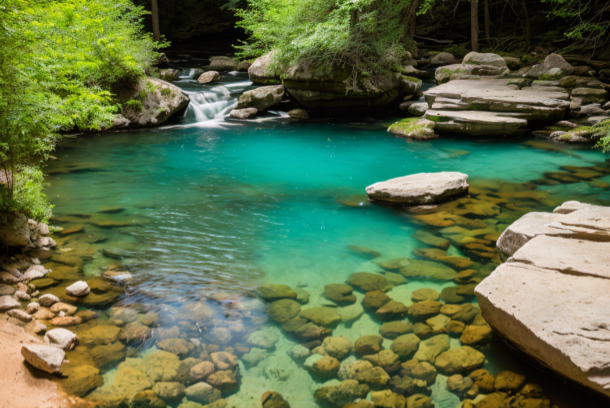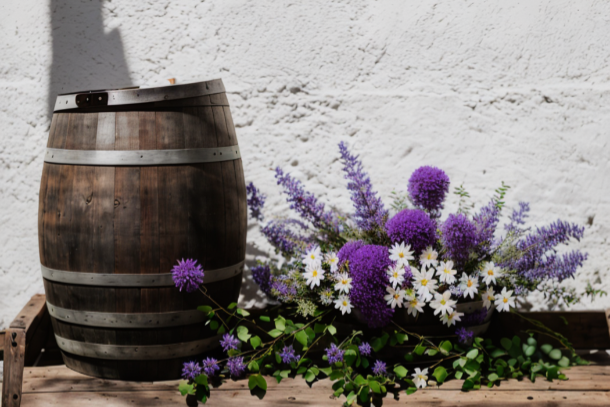5 Natural Ways to Harness Water for Relaxation

In our bustling, modern lives, filled with technological distractions and ever-growing to-do lists, moments of relaxation often seem few and far between. Yet, it is these moments, these pauses from the hurried pace of life, that are vital for our mental health and overall well-being. Relaxation helps to lower our stress levels, boost our mood, and rejuvenate our minds and bodies, ultimately enabling us to better handle life's challenges.
Scientists and health practitioners have long emphasised the importance of incorporating relaxation techniques into our daily routines. Yet, in the constant hustle and bustle, finding effective methods that align with our preferences and lifestyles can sometimes seem like a challenge.
The Healing Power of Water
This is where the power of nature, and more specifically, the power of water, comes into play. Water has been associated with relaxation and tranquillity for centuries, with its soothing sounds, rhythmic movements, and immersive qualities providing a natural salve for stress and anxiety. In various cultures, water is viewed as a symbol of clarity, calmness, and renewal. Even science acknowledges the therapeutic impact of water on our psyche - a concept termed the 'blue mind' theory.
In this article, we will explore five ways to harness the calming properties of water in nature. Whether you're a city dweller seeking a respite from urban life or someone fortunate enough to live close to natural water sources, these methods will offer new dimensions to your relaxation routine. Let's dive in.
Walking by a Stream or River
The Calming Effects of Strolling Near Running Water
When it comes to utilising the soothing effects of water, a simple walk by a stream or river can be profoundly calming. The gentle burbling sound of running water can effectively lower stress levels by inducing a state of relaxation. This sound has the ability to mask harsher, more jarring noises, allowing our minds to focus on the rhythmic ebb and flow of the water. Coupled with the verdant beauty of nature that often surrounds these water bodies, the overall effect is an unparalleled natural stress reliever.
Research suggests that environments with water, known as blue spaces, can improve mood and reduce negative mental states. The mere sight of water, with its continuous movement, can engender a meditative state, reducing mental chatter and promoting a sense of tranquillity.
Maximising the Experience: Tips and Suggestions
To truly harness the relaxation benefits of walking by a stream or river, consider the following tips:
-
Mindfulness Techniques: Try to be present in the moment, absorbing the sights, sounds, and even smells around you. Feel the ground under your feet, listen to the water flow, and observe its path and interaction with the surroundings.
-
Ideal Times of Day: Opt for early mornings or late evenings when the surroundings are typically quieter. These times often offer a different perspective of the scenery, with the soft light enhancing the calming experience.
-
Suitable Locations: Not all rivers or streams are the same. Choose locations that are safe, clean, and resonate with your personal preferences. Tranquil and less crowded spots often provide a more soothing experience.
Incorporating a regular waterside walk into your routine can be a small change that yields significant relaxation benefits. So why not lace up your walking shoes, head to your local river or stream, and let the water work its calming magic?
Way 2: Swimming in a Natural Body of Water
The Tranquilizing Benefits of Nature's Pool
Swimming is not only an excellent full-body workout, but when it takes place in natural bodies of water, such as lakes, rivers or the sea, it also offers unique physiological and psychological benefits. The sensation of cool, fresh water on your skin can immediately awaken your senses and release tension from your body.
From a physiological standpoint, the gentle resistance of the water provides a low-impact exercise that helps tone muscles and improve cardiovascular health. Moreover, the buoyancy of water reduces strain on joints, making swimming a suitable relaxation activity for almost everyone.
On a psychological level, immersion in nature helps you disconnect from the hum of modern life. The experience promotes a state of mindfulness, where the mind's focus shifts from daily concerns to the rhythm of your breathing and strokes, the feel of water against your skin, and the sights and sounds of nature around you. This mindful immersion can help reduce stress and anxiety levels, further enhancing the relaxation effect.
Staying Safe and Enhancing the Experience
Safety is paramount when swimming in natural bodies of water. Always check the depth and current before entering, be aware of potential hazards like rocks or strong tides, and never swim alone in isolated areas. If you're swimming in the sea, stay close to the shore unless you're a highly confident and strong swimmer.
To further enhance the relaxing benefits, consider incorporating mindful practices into your swimming sessions. For instance, focus consciously on your breathing patterns, the sensation of the water, and the sounds of nature. This mindful approach can deepen the relaxation benefits, turning a simple swim into a soothing, sensory meditation.
Way 3: Listening to the Rain
The Soothing Influence of Rain Sounds
The gentle patter of rain on leaves, the rhythmic drumming on a rooftop, or the soft whispers of a light drizzle; these sounds can be incredibly soothing. But why is that? The calming effect of rain sounds lies in their predictability. Our brains tend to relax when presented with simple, repetitive stimuli, and the consistent pattern of rain provides just that.
Moreover, rain sounds often fall into what's called 'pink noise.' Unlike white noise, which has a higher frequency, pink noise includes all frequencies we can hear but with a bias towards lower, more calming frequencies. This type of noise has been scientifically shown to improve sleep quality and increase the sense of tranquillity.
Mindfully Engaging with Rain Sounds
Now, how can we fully immerse ourselves in this calming auditory experience? If you're indoors, consider simply opening a window and allowing the sounds to permeate your living space. Turn off any distractions, such as television or loud music, and let the gentle rhythm of the rain captivate your attention.
Alternatively, you could use the sounds of the rain as a background for a mindfulness meditation session. Focus on the varying tones, rhythms, and volumes of the rain sounds, letting them anchor you in the present moment.
If you're outdoors, find a safe and dry spot under a canopy or large tree. Close your eyes and concentrate on the rain's patter around you. Feel the moisture in the air, smell the fresh, earthy aroma that rain often brings, and let yourself be one with the soothing symphony of nature.
Way 4: Boating or Sailing on a Lake or Sea
Sailing into Serenity
Boating or sailing on a lake or sea provides an unmatched avenue for relaxation. Picture yourself aboard a gently bobbing boat, the rhythm of the waves lulling you into a state of tranquillity. This activity combines the soothing sway of water and the calming beauty of natural vistas to form a perfect backdrop for relaxation.
The visual feast of undulating waves, the limitless horizon, and the rhythmic dance of sunbeams on the water's surface can provide immense psychological relief. The gentle hum of the boat engine or the sound of the wind filling the sails can further accentuate this calming experience.
Notably, the act of steering a boat or raising a sail also requires a level of focus that can help quiet the mind, offering a form of moving meditation.
Navigating Practical Considerations
For those new to boating or sailing, it's important to consider a few practical points. First, look into local boat or yacht rental options, many of which offer services that include a brief training session and safety instructions.
Speaking of safety, always ensure you're equipped with the necessary gear, including lifejackets, and are aware of safety protocols. Check the weather forecast before heading out and, if possible, start on calm waters to familiarise yourself with the experience.
Remember, like all forms of relaxation, boating or sailing should be approached in a manner that prioritises comfort and peace of mind over any form of challenge or competition. The goal is to let the serenity of the water soothe your senses and revitalise your spirit.
Observing the Ebb and Flow of Tides
The Calming Rhythm of Tides
Our fifth and final voyage into relaxation with water in nature brings us to the captivating spectacle of the ebb and flow of tides. Much like a visual lullaby, the rhythmic dance of the tides has a uniquely calming influence that invites a state of deep relaxation. Observing this steady, natural phenomenon provides a soothing, almost hypnotic experience, allowing the viewer to disconnect from their bustling thoughts and simply be present in the moment.
The ebb and flow of the tides serve as a potent reminder of the rhythmic nature of life itself - the constant cycle of change, the give and take, the rise and fall. This connection with nature's rhythms can foster a profound sense of peace and tranquillity, making it an ideal relaxation practice.
Ideal Spots and Maximising Relaxation
When it comes to choosing a spot for tide watching, opt for locations that afford a wide, unobstructed view of the water. Coastal beaches, especially those with a direct view of the horizon, make excellent locations. Areas around estuaries can also provide unique experiences as freshwater and seawater mix in a tidal ballet.
To maximise the relaxation potential of this experience, it's worth incorporating some mindful practices. As you observe the tides, maintain a gentle awareness of your breath, letting it synchronise with the ocean's rhythm. Acknowledge the sounds, the sight, and the sensation of the breeze. Embrace this immersive experience and let nature's soothing spectacle bring a tide of tranquillity to your mind.
Reflecting on the Tranquil Journey
Our exploration of the intertwining of relaxation and nature's waters has taken us on a serene journey, revealing five immersive ways to leverage this soothing element for stress relief. We started on the banks of gently babbling streams and rivers, discussing the calming effects of such waterside strolls and offering practical tips for enhancing these soothing sojourns with mindfulness techniques.
Next, we plunged into the refreshing embrace of natural bodies of water, from tranquil lakes to vast seas, illuminating the physiological and psychological benefits that swimming in such places can bring. We offered advice on safety measures and strategies to maximise the relaxation potential of these immersive experiences.
From there, we retreated indoors to the comforting sound of rain falling, explaining the science behind its calming influence on our brains. We suggested ways to engage mindfully with the rhythmic patter of raindrops, whether you find yourself indoors or out in nature.
Our journey then took to the waters, exploring the therapeutic sway of boating or sailing on a lake or sea. We detailed the relaxing influences of such experiences and shared practical advice for beginners to navigate these tranquil waters safely.
Finally, we found tranquillity in the rhythmic ebb and flow of the tides, detailing the calming effect of observing this natural spectacle and offering suggestions for ideal spots to experience it.
Inviting You to Embrace the Calm
With these five methods of harnessing the relaxation power of water in nature at your disposal, why not dive in? Whether you choose to stroll by a river, swim in a lake, listen to the rain, sail on serene waters, or observe the calming motion of tides, tranquillity is but a splash away. So go ahead, immerse yourself in the soothing embrace of nature's waters and experience the profound relaxation benefits firsthand.
Related to this article are the following:
- Weather Sounds to Help You Sleep: Rain, Wind, Snow and Storms
- The Magic of Chair Massage: Unwinding in the Modern World
- Aromatherapy Massage: The Journey to a Sensory Nirvana
- Experience the Warmth: Uncovering the Benefits and Techniques of Hot Stone Massage
- Experience the Multifaceted Benefits of Swedish Massage
I do hope you have enjoyed this article and hope that you will subscribe to my newsletter so you can get the latest information about all things naturally relaxing.
Stay in touch, join the Naturally Relaxing Newsletter
Newsletter Signup
Post Your Comments
or post as a guest
Be the first to comment.
Latest articles in Water
Idea is to do article on waterfall

Finding the Perfect Swimming Hole: Your Comprehensive Guide

Exploring Sea Deities Around the World: A Dive into Global Mythologies

Harvesting Rainwater: A Comprehensive Guide to Rain Barrels and Water Storage

Creating Resilient Gardens: An Expert Guide to Drought-Tolerant Landscaping






